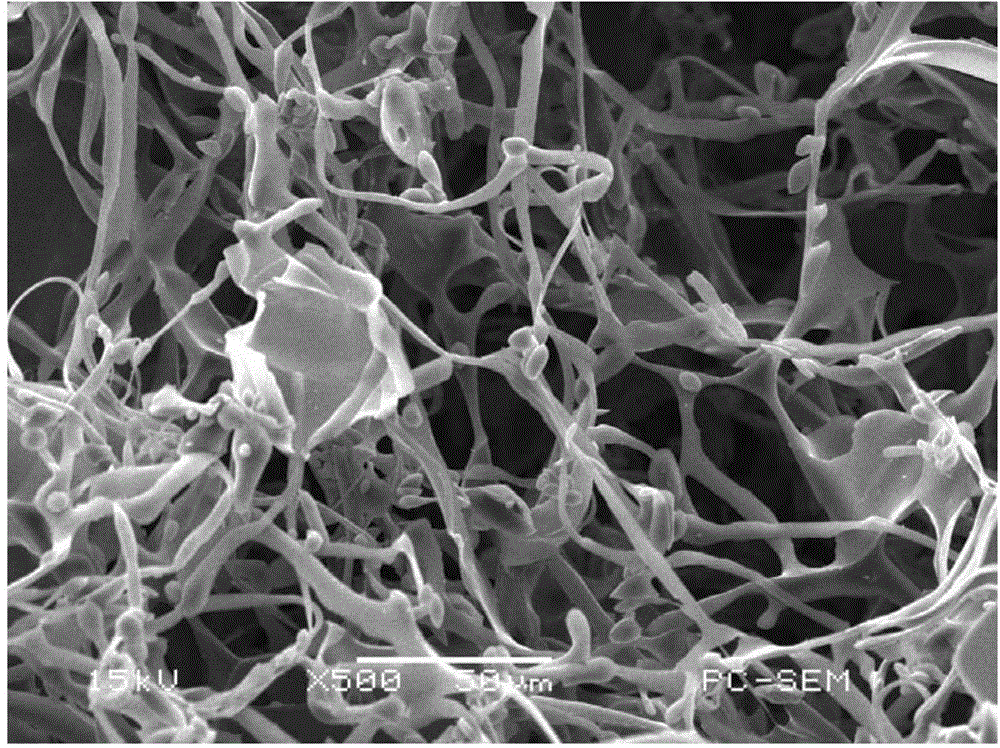Method for preparing pH-value-sensitive crosslinked fiber through low-temperature photopolymerization
A technology of low-temperature photopolymerization and photopolymerization of monomers, applied in the field of polymer materials, can solve problems such as taking a long time, and achieve the effect of simple preparation method and high degree of fiber formation
- Summary
- Abstract
- Description
- Claims
- Application Information
AI Technical Summary
Problems solved by technology
Method used
Image
Examples
Embodiment 1
[0026] With methacrylic acid and water-soluble polyethylene glycol (600) diacrylate mixture and photoinitiator 2959 (methacrylic acid / water-soluble polyethylene glycol (600) diacrylate mass ratio=0.1 / 9.9, 2959 Mass ratio with methacrylic acid and water-soluble polyethylene glycol (600) diacrylate mixture = 0.1 / 1) dissolved in solvent water (methacrylic acid and water-soluble polyethylene glycol (600) diacrylate mixture Mass ratio with water = 1 / 100), frozen at 0°C low temperature to freeze and crystallize water, cross-linked with ultraviolet light source light at 0°C low temperature, freeze-dried to remove solvent water, to obtain pH-sensitive cross-linked fibers, such as figure 1 shown.
Embodiment 2
[0028] The mixture of acrylic acid and water-soluble polyethylene glycol (20000) diacrylate and water-soluble camphorquinone photoinitiator (acrylic acid / water-soluble polyethylene glycol (20000) diacrylate mass ratio=9.9 / 0.1, The mass ratio=0.001 / 1 of the mixture of water-soluble camphorquinone photoinitiator and the mixture of acrylic acid and water-soluble polyethylene glycol (20000) diacrylate) is dissolved in solvent water (acrylic acid and water-soluble polyethylene glycol (20000) ) a mixture of diacrylate and water (mass ratio = 1 / 1000), freeze quickly at a low temperature of -197°C to freeze and crystallize the water, cross-link with visible light at a low temperature of -197°C, freeze-dry to remove solvent water, and obtain pH sensitive crosslinked fibers.
Embodiment 3
[0030] Mix N,N dimethylpropylacrylamide and water-soluble polyethylene glycol (4000) diacrylate mixture with water-soluble thioxanthone photoinitiator (N,N dimethylpropylacrylamide / water-soluble Proactive polyethylene glycol (4000) diacrylate mass ratio=5 / 5, water-soluble thioxanthone photoinitiator and N, N dimethyl propyl acrylamide and water-soluble polyethylene glycol (4000 ) mass ratio of diacrylate mixture=0.005 / 1) dissolved in solvent water (N, N dimethyl propyl acrylamide and water-soluble polyethylene glycol (4000) mass ratio of diacrylate mixture=5 / 10000 ), frozen at -50°C to crystallize the water, cross-linked with ultraviolet light at a low temperature of -20°C, and freeze-dried to remove solvent water to obtain pH-sensitive crosslinked fibers.
PUM
 Login to View More
Login to View More Abstract
Description
Claims
Application Information
 Login to View More
Login to View More - R&D
- Intellectual Property
- Life Sciences
- Materials
- Tech Scout
- Unparalleled Data Quality
- Higher Quality Content
- 60% Fewer Hallucinations
Browse by: Latest US Patents, China's latest patents, Technical Efficacy Thesaurus, Application Domain, Technology Topic, Popular Technical Reports.
© 2025 PatSnap. All rights reserved.Legal|Privacy policy|Modern Slavery Act Transparency Statement|Sitemap|About US| Contact US: help@patsnap.com

